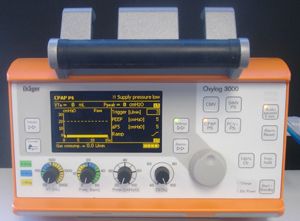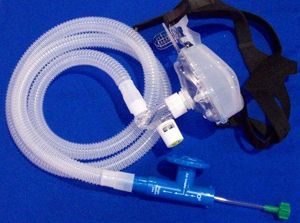By Dan White
 Photo by Dan White A displayed version of the FloPAPP. |
Imagine a scenario where your patient is starving for oxygen and his eyes are saying to you, “Please don’t let me die.” You can hardly hear any air exchange in the man’s lungs. Time is running out for this sick CHF patient — what do you do that allows the patient to avoid a dangerous and costly trip to the ICU on a ventilator?
In the old days we would have first reached for the intubation kit and the Lasix, but today our medics reach for the CPAP machine.
I hear a lot of these kinds of scenarios being solved by CPAP technology since they first emerged as a viable pre-hospital therapy about five years ago. It’s no wonder why it’s one of the two fastest growing new clinical technologies in EMS.
CPAP stands for Constant or Continuous Positive Airway Pressure; sometimes it’s called Non-Invasive Ventilation. It reduces the need for intubation, improving outcomes for CHF patients. It’s also been used for COPD and even reviving drowning victims. Think of CPAP as “oxygen therapy on steroids.”
CPAP consists of two distinct functions. The first is to raise the patients inspiratory pressure above atmospheric, enough to reduce the work of breathing. The second part is to apply PEEP, or Positive End Expiratory Pressure, to the expiratory phase of respiration. CPAP is delivering positive airway pressure during BOTH phases of respiration.
There are four different ways to deliver CPAP in the field:
- 1. Downs Flow Generator
- 2. Demand-Flow
- 3. Ventilator with CPAP functionality
- 4. Disposable
1. The Downs Flow Generator
The Downs Flow Generator is the original CPAP machine. There are currently two distinct types of Downs Flow device — the Adjustable Flow and the Fixed Flow. They are simple and rugged devices featuring a DISS input, round or square shaped expansion chamber, venturi air entrainment port, and circuit connection.
The expiratory phase is controlled separately at the patient mask with a PEEP valve. The non-adjustable type PEEP valves work better than adjustable PEEP valves, but make it less convenient and more expensive to adjust pressure.
The latest version of the Adjustable Downs Flow type CPAP is the new FloPAPP from Flotec, Inc. The FloPAPP features adjustable aspiratory flow rates and an adjustable PEEP valve on the mask. This allows the clinician to slowly increase PEEP pressure to protocol-based pressure objective or patient tolerance. With adjustable inspiratory flows, you can also better match the flow rate to the patient’'s inspiratory drive (I also really like the compact disposable patient circuit).
2. Demand-Flow
 Photo by Dan White The PortO2Vent. |
There are currently two demand-flow types of CPAPs on the market: the Emergent PortO2Vent and the Airon MACS CPAP. Both of these high-quality devices provide infinitely variable PEEP, a built-in pressure gauge, and they only flow oxygen during inspiration, for reduced oxygen consumption and easier patient monitoring.
The PortO2Vent is extremely popular among EMS Providers. In May of 2007, the largest hospital system in Texas and Houston Fire EMS implemented a pre-hospital CPAP program using the PortO2Vent. They were able to reduce the number of CHF patients that required intubation. We all know this is a good thing since it’s those ELECTIVE intubations that have the most potential to get you into trouble.
3. Ventilator with CPAP functionality
 Photo by Dan White The Oxylog 3000. |
These are several great devices on the market, including the LSP AutoVent 4000, CareVent ALS+, Impact’s 754 and new 731, and the Draeger Oxylog 3000. A few can deliver either CPAP or BiPAP at the preference of the physician. Most have advanced respiratory monitoring capabilities well beyond those found on the other types of EMS CPAP devices. And they can all serve at least three different roles: work as a CPAP, provide controlled mandatory ventilation for emergency patients, and or work during patient transports as a ventilator.
4. Disposable
The Boussignac CPAP device is an oxygen-powered disposable device that provides expiratory pressure support generated by the flow of oxygen from a standard regulated oxygen source. It also provides oxygen enrichment; however, since PEEP is tied to oxygen flow rate, it cannot deliver low PEEP at high FIO2. The only other drawback is that is does not provide Inspiratory Pressure Support, the other part of what makes CPAP beneficial.
Another disposable option is the Smith Oxy-PEEP. This product features a variable FIO2 venturi, non-rebreathing bag, and variable PEEP valve. It can provide low PEEP and high FIO2 simultaneously, but it also does not support inspiration with positive airway pressure.
 Photo by Dan White The O2ResQ. |
The latest disposable CPAP device worth noting is the new O2ResQ. The O2ResQ is a true disposable CPAP of the fixed Downs Flow type. It’s very simple and easy to use; it uses an innovative plastic expansion chamber with venturi air entrainment port, and offers different threshold resistor style PEEP valves. In the LTS EMS Council Region of upstate Pennsylvania, they will soon be implementing use of the O2ResQ for BLS providers.
CPAP has really come of age in EMS. Once all we had was the choice between an oxygen mask and an ET tube. In medic school we learned a lot about how to breathe for patients that cannot breathe on their own. For the first time, CPAP gives us a practical tool for helping patients ventilate better before they stop breathing.
Over half the EMS agencies that could use CPAP under their state protocols now do. If your agency is not among them, it’s time you took another look — before you get that look from a CHF patient who really needs it.












